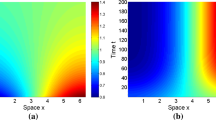Abstract.
If in the classical Turing model the diffusion process (Brownian motion) is replaced by a more general correlated random walk, then the parameters describing spatial spread are the particle speeds and the rates of change in direction. As in the Turing model, a spatially constant equilibrium can become unstable if the different species have different turning rates and different speeds. Furthermore, a Hopf bifurcation can be found if the reproduction rate of the activator is greater than its rate of change of direction, and oscillating patterns are possible.
Similar content being viewed by others
Author information
Authors and Affiliations
Additional information
Received 24 February 1995; received in revised form 6 September 1995
Rights and permissions
About this article
Cite this article
Hillen, T. A Turing model with correlated random walk. J Math Biol 35, 49–72 (1996). https://doi.org/10.1007/s002850050042
Issue Date:
DOI: https://doi.org/10.1007/s002850050042




